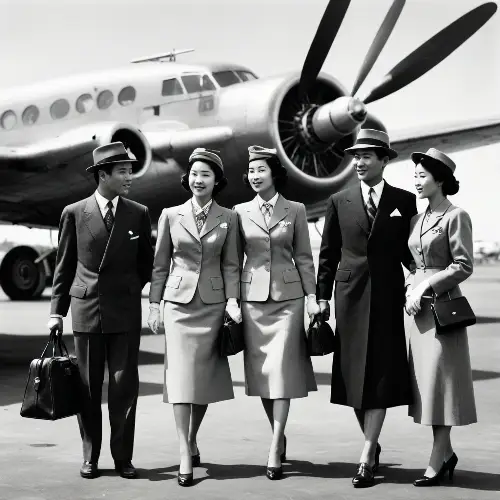the logo of museum of Foreign Economic and Trade Relations,logo,plane,interesting picture
A large aviation academy with an interesting architectural design with a short runway for aircraft and containing three aircraft hangars , top view
A large aviation academy with an interesting architectural design with a short runway for aircraft and containing three aircraft hangars , top view
This black and white photograph captures a historical moment, likely from the mid-20th century, judging by the style of the airplane and the attire of the people. A group of passengers is boarding or gathering near an old propeller-driven aircraft, which has its entry door open, indicating readiness for boarding or deplaning. The passengers are dressed in formal attire that was typical of the era when air travel was a luxury experience. The men are wearing suits and hats, and the women are in dresses with some wearing hats as well. There is at least one flight attendant or a member of the crew visible, identifiable by a uniform that stands out from the passengers' attire. There is a sign with Japanese characters visible, suggesting the location might be in Japan or related to a Japanese airline.
This black and white photograph captures a historical moment, likely from the mid-20th century, judging by the style of the airplane and the attire of the people. A group of passengers is boarding or gathering near an old propeller-driven aircraft, which has its entry door open, indicating readiness for boarding or deplaning. The passengers are dressed in formal attire that was typical of the era when air travel was a luxury experience. The men are wearing suits and hats, and the women are in dresses with some wearing hats as well. There is at least one flight attendant or a member of the crew visible, identifiable by a uniform that stands out from the passengers' attire. There is a sign with Japanese characters visible, suggesting the location might be in Japan or related to a Japanese airline.
\"NAKED\", Stooped Blue lizard man without clothes to the waist, medieval, naked, torn baggy breeches, brown, naked scaly chest, sword belt, loincloth and belt with a plaque in the form of a snake's eye, noir, dark, scale detailing, massive paws detailing, stands on the deck of a pirate ship Guns are firing at the ship, splinters of wood and gunpowder smoke, clouds and blood are flying
\"NAKED\", Stooped Blue lizard man without clothes to the waist, medieval, naked, torn baggy breeches, brown, naked scaly chest, sword belt, loincloth and belt with a plaque in the form of a snake's eye, noir, dark, scale detailing, massive paws detailing, stands on the deck of a pirate ship Guns are firing at the ship, splinters of wood and gunpowder smoke, clouds and blood are flying
Aircraft autonomously flying, showcasing its unmanned state and unpredictable trajectory.
Design and Model: The aircraft would typically be a fighter or bomber model such as the P-51 Mustang, B-17 Flying Fortress, or B-24 Liberator. Fighters were sleek, single-seat aircraft, while bombers were larger, multi-crew machines. Livery and Markings: These airplanes often had olive drab or silver aluminum fuselages. They featured specific insignias like the white star in a blue roundel, often with white bars extending from the sides. Squadron markings and individual aircraft identification numbers were also common. Armament: Fighter planes were equipped with machine guns or cannons, usually mounted on the wings. Bombers had multiple gun turrets for defense against enemy fighters, in addition to their bomb load. Propulsion: Most of these planes were propeller-driven. Fighters had single engines, while bombers had multiple engines (usually four). The propellers were typically three-bladed and made of metal. Cockpit and Canopy: The cockpits were relatively small with limited visibility. The canopy on fighters was often a teardrop shape, while bombers had larger, more complex cockpit structures. Wings and Tail: Fighters had distinct, often elliptical wing shapes for maneuverability, while bombers had larger, straighter wings for stability and payload capacity. The tail design varied, but vertical and horizontal stabilizers were prominent features. Size and Build: Fighters were compact and agile, built for speed and maneuverability. Bombers were much larger, designed for long-range missions and heavy bomb loads. Historical Significance: These aircraft played crucial roles in various theaters of the war, from the European to the Pacific fronts. They were instrumental in air superiority, ground support, and strategic bombing campaigns.
Design and Model: The aircraft would typically be a fighter or bomber model such as the P-51 Mustang, B-17 Flying Fortress, or B-24 Liberator. Fighters were sleek, single-seat aircraft, while bombers were larger, multi-crew machines. Livery and Markings: These airplanes often had olive drab or silver aluminum fuselages. They featured specific insignias like the white star in a blue roundel, often with white bars extending from the sides. Squadron markings and individual aircraft identification numbers were also common. Armament: Fighter planes were equipped with machine guns or cannons, usually mounted on the wings. Bombers had multiple gun turrets for defense against enemy fighters, in addition to their bomb load. Propulsion: Most of these planes were propeller-driven. Fighters had single engines, while bombers had multiple engines (usually four). The propellers were typically three-bladed and made of metal. Cockpit and Canopy: The cockpits were relatively small with limited visibility. The canopy on fighters was often a teardrop shape, while bombers had larger, more complex cockpit structures. Wings and Tail: Fighters had distinct, often elliptical wing shapes for maneuverability, while bombers had larger, straighter wings for stability and payload capacity. The tail design varied, but vertical and horizontal stabilizers were prominent features. Size and Build: Fighters were compact and agile, built for speed and maneuverability. Bombers were much larger, designed for long-range missions and heavy bomb loads. Historical Significance: These aircraft played crucial roles in various theaters of the war, from the European to the Pacific fronts. They were instrumental in air superiority, ground support, and strategic bombing campaigns.
































































































